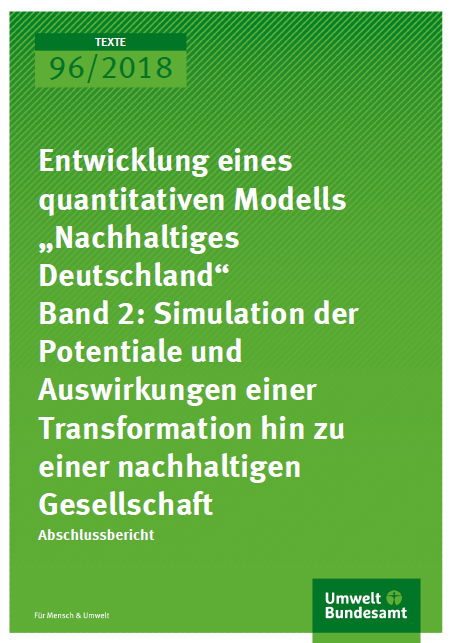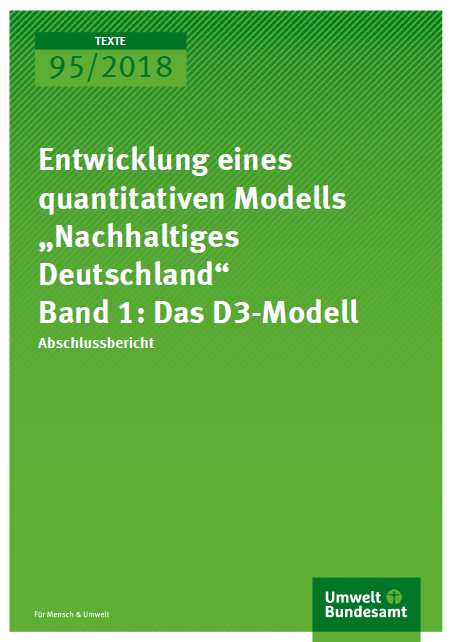Entwicklung eines quantitativen Modells "Nachhaltiges Deutschland" – Band 2
Band 2: Simulation der Potentiale und Auswirkungen einer Transformation hin zu einer nachhaltigen Gesellschaft
- Publication
- Citation
Neumann, K.; Grimm, F.; Diefenbacher, H.; Hirschnitz-Garbers, M.; Langsdorf, S.; Schipperges, M.; Weiss, D., (2018). Entwicklung eines quantitativen Modells "Nachhaltiges Deutschland" – Band 2: Simulation der Potentiale und Auswirkungen einer Transformation hin zu einer nachhaltigen Gesellschaft. German Environment Agency, Dessau-Roßlau. (avilable in German only)
For the Federal Environment Agency of Germany a consortium of Consideo, adelphi, Ecologic Institute, FEST and sociodimensions developed a quantitative simulation model to run scenarios on the potentials for a transition of society towards sustainability. The model explores the effects of a transition on the environment, climate change, use of resources, the economy, welfare, and happiness. The report is available for download.
The results from this project are documented in four parts:
- The quantitative D3 model (D for Deutschland, 3 for society, economy and politics): The report describes the cause and effect model with its more than 4,000 factors and how it can be used. The Federal Environmental Agency can directly use the model to alter and enhance it and to answer different questions.
- The simulation of potential transitions towards sustainability and their effects. The report also covers insights on the possibilities and limitations of the simulation of social systems.
- The simulation of the shift towards renewable energy (D3 EE model): The report describes an additional simulation model that looks more into the details of the use of renewable energy and its implications for the use of resources as well as its economic effects.
- The D3 simulation: The report describes a separate model that can be used as a simulation game to allow e.g. pupils to play the roles of citizens, politicians, or business-people and experience their interdependencies through the lock-in effect and the spillover effects as they are explained in this report at hand.
The D3 model can be used to generate findings on societal interactions in interplay with increasing technical efficiency, social innovations, eco-sufficiency approaches, and socio-economic effects (e.g. rich/poor, migration, aging societies). The goal was to use the "Sustainable Germany" model to better understand the dynamic interaction between the different aspects of the three dimensions of sustainability "ecology", "economy" and "social system") within the planet's carrying capacity and, in doing so, to advance our systematic understanding of sustainable development overall.
The project showed that the simulation of social systems with system dynamics is feasible. To endogenously simulate the behavior of humans it is crucial to translate human motivation into factors and formula. Provided that the change of behavior is emotionally effective an exponential transition through spillover effects between different areas (nutrition, mobility, housing, clothing, etc.) for each social milieu as well as spillover effects between the social milieus seems possible. The effects on the environment, climate, resources, welfare and happiness would be beneficial. The effects on the economy could after a medium term increase become stable on today’s level.




